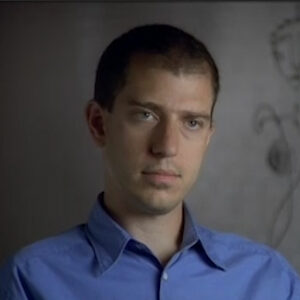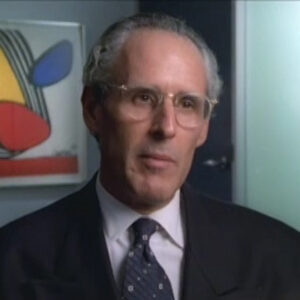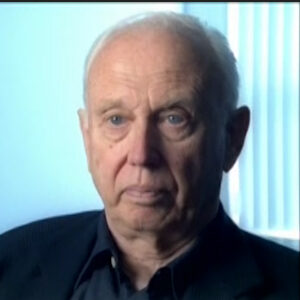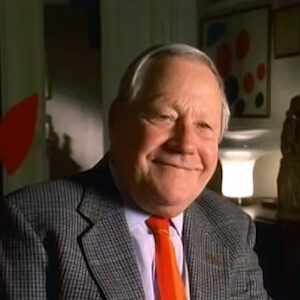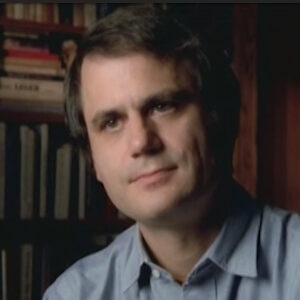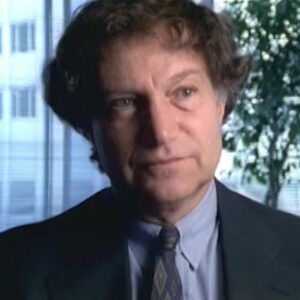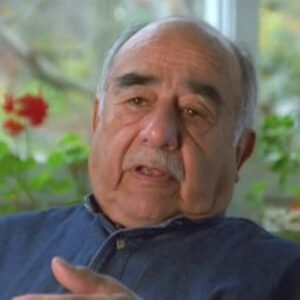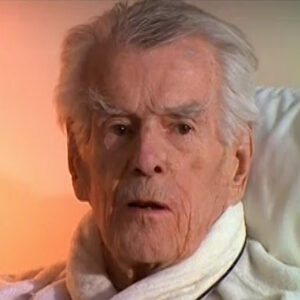Arne Glimcher Calder is one of the revolutionaries that changed the history of sculpture. The most radical change in any of the arts during the 20th century happened to sculpture, sculpture was always something that was made from a solid block of material whittled away, cut away, chipped away, such as marble or one, or built up out of clay and then cast in bronze. Picasso took existing objects and put them together and said, this is sculpture. That was the great revolution. That was. That was the great revolution in 20th century sculpture and in 20th century art. Calder makes the next giant step. And he says the other quality that sculpture always has. Even the Picasso’s is wait and some kind of mass. What I will do is create a sculpture that is weightless, that is antithetical to any of the properties that have ever existed in the concept of sculpture or in the display of sculpture. This for me is the great one of the great revolutions of the 20th century.
Interviewer: Describe your experience with a Calder you’ve obviously seen hundreds or thousands, you’ve lived with them in their home. What is it like?
Arne Glimcher Well, Calder’s sculpture is a constantly changing examination of the space that is within which it exists and relationships, almost mathematical relationships or relationships like the stars and planets. What a called does is extend your perception to them. What were previously called the negative areas rather than the positive areas, so that the material that he uses is a fraction of the importance of the piece, the pieces, the space within the confines that those materials describe as they orbit. This shapes orbit each other.
Interviewer: Can you describe the experience of yourself looking at.
Arne Glimcher No.
Interviewer: No. OK. Talk about the inventiveness, not just this revolution, but the man who. Did many different media. But you can see him.
Arne Glimcher Well, there is enormous invention in turning. Form into gesture. I mean, if Calder’s works are familiar in any way and strike a chord with a mass audience, they’re not because he’s making a sculpture of a swan, but because the piece has the gesture of the head of the swan moving in the water or the head of a bird. It is about nature and does not look like nature in any way, so that we recognize these movements and gestures in Calder’s work without having the association or. Description of the object. These are very unique qualities in 20th century art. Calder is a revolutionary. I mean, this art that is apparently playful and charming is art that is ruthless in the history of its discipline.
Interviewer: Say more. Why is ruthless?
Arne Glimcher Because it shatters the illusion of everything that sculpture ever was it. It embraces gesture where other sculptors embrace form. It is unlike any body of work created this century.
Interviewer: I would have thought that mobiles were invented in ancient Egypt. Pertaining. Is it that this particular this former US ambassador. Mind blowing. Someone could invent a new art form.
Arne Glimcher Well, genius invents new forms. It’s not a question of inventing new forms as much as encapsulating and isolating ideas. These ideas were in the air. Calder was the locus that assimilated and presented this idea for its time. Another very radical aspect of the work is if you think about the circus and the performances Calder gave of the circus. Think about performance art in the 90s. Certainly it stems from that. These were the first great performances by an artist this century, and certainly they were thought of performances. But this was something else. This was a self-contained performance that varied with each playing. And again, he opens the door for environment. He opens the door for performance art. He opens the door for movement and sculpture, for weightlessness, for breaking all of the rules.
Interviewer: Why was the circus as we talked about? What was it the hot night l out in Paris? Now in the 90s, cute Sikandar?
Arne Glimcher Well, it was like nothing we had ever seen. And I mentioned before the idea of gesture rather than form. And of course, the circus only comes to life with Calder. What we’re seeing are artifacts of the circus, which are not as interesting as the performance. It’s like the are the Germanized Joseph Boice, the vitrines that that museum’s prize have, the vestiges of performance within them. Those vestiges don’t interest me very much. They don’t have the life that the performance has. They’re all we have. Calder, of course, we have a lot more. We have an entire body of work besides the circus. But what we’re looking at is a beautifully, inventively, humorously crafted objects. But the performance bringing those objects to life is what the work was about, not the objects themselves. Again, it was the gesture rather than the form.
Interviewer: So would you say that he invented the mobile?
Arne Glimcher Sure. I mean, would you say that Einstein invented the theory of relativity? You know, it is. People take quantum leaps for ideas.
Interviewer: No one is yet actually said that.
Arne Glimcher Sure, he. You know, when he invented he invented a new idea of movement in sculpture. The mobile is only part of it. Mobiles have become part of the vernacular, but they have nothing to do with what Calder did. You know that the mobile hanging over your child’s crib is an amusement for the child? Calder is not making amusements. Calder is an extraordinary researcher researching perception, the boundaries of perception, extending our perception to see spaces, movements, gestures that we that were previously invisible.
Interviewer: Did did he continue to push his art or did he make a fe mobiles and then rest on his morals?
Arne Glimcher No Calder’s art from the in the late 50s and early 60s create a new kind of monumental sculpture. Again, just as he simplified sculpture to this kind of weightlessness, he created a new kind of monumental sculpture that gave you the illusion of solid form and mass. But we’re actually girders a kind of shorthand for these creatures. Flamingo in Chicago is the embodiment of Flamingo, but it doesn’t look like a flamingo. It has very little mass to it. It occupies an enormous amount of space. The supports that that the elements that provide support for these girders become the implied three dimensional form of the girders. So Calder’s art continues, you know, through his life. Very prolific artist and could be very capricious and make things that were amusing and gifts which he would occasionally give to people. And he could make art that shattered the boundaries of what sculpture was.
Interviewer: It was. Let’s go way back. Wire wire sculpture, wire portraits. That’ his invention also. Talk about that.
Arne Glimcher Picasso makes the first really linear wire sculptures. That was where Calder really came from. What’s those early sculptures of by by Picasso. However, Calder’s wire portraits were kind of drawing in space that was more immediate and more direct. As the pieces really weren’t welded together, it was taking a line and playing with that line in space and working the portraits. Portraits are extraordinary. They and the sculptures of Josephine Baker and Romulus and Remus. And they’re filled with a kind of humor, but they’re also filled with this kind of implied form that decades later we find in the stabiles like Flamingo and Man. And so that’s kind of a straight line from the linear pieces, from those wire sculptures to the the great state bills of the 60s. But, you know, called her again in this in the late 50s and 60s, creates a new kind of heroic, monumental sculpture, something that we had never seen. And then artists come after him like Richard Sara, certainly Mark di Suvero.
Interviewer: The seriousness of the art?
Arne Glimcher Calder isn’t childlike in the sense that people think it is. Calder is innocent. Every great artist is a great artist because he perceives the world as though it’s being seen for the first time. That is the innocence of Calder. The closer and closer one gets to a pure vision of innocence, the more childlike it seems. Well, that’s an enormous compliment because a child is it is a perceiving for the first time. But Caulder is in a very serious enterprise. Another reason that people consider maybe the world child like the work childlike.
Interviewer: Start again.
Arne Glimcher Another reason people sometimes consider the work childlike or or even the work of a tanker, which I find half annoying and half complimentary, is because the material he uses ah is very different than the material other artists use. It is a pliers and tweezers and a bending and a tinkering to the construction. It isn’t. He’s not welding. There aren’t helmets. There aren’t sprays of show of fire, but called his work is very masculine, is very serious. Is the work of an engineer, is the work of a mathematician, but also strikes this chord of pure innocence. And it’s, again, it’s power of the work that a work like man which weighs umpteen tons can have at once such immediacy and freshness that you can say that it’s majestic and you can say that it’s playful but playful in the same way the pyramids are playful.
Interviewer: Wonderful. Exactly where we wanted to go. What should we know? So we know that Calder the man, the person?.
Arne Glimcher Everything we should know about Calder the man and the person is in the work. I, I, I didn’t know Calder very well. I knew him from the art world. I knew him from meeting him at openings and being occasionally at parties with him. And I don’t know very much about Calder anecdotally. I know a great deal about Calder from the work to life and the work are inseparable. These mobiles and stabiles and drawings and structures describe Calder. Describe someone who is endlessly restless, inventive, occupied, searching, finding.
Interviewer: How do you think he should be remembered? What is his place in history?
Arne Glimcher He created one of the great revolutions of the 20th century. He changed the nature of sculpture. He redefined what sculpture was, could possibly be, and now is.
Interviewer: Let’s cut picture and just sit for 30 seconds, because we.


